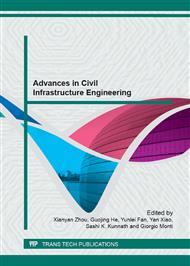p.539
p.544
p.548
p.554
p.567
p.573
p.577
p.581
p.587
Study on the Constitutive Model of Visco-Elasticity-Plasticity Considering the Rheology of Rock Mass
Abstract:
Considering the rheological mechanical characteristics of rock mass, a viscous-plastic model of rock mass which can describe the acceleration creep stage of rock mass was proposed. Moreover, combining with viscous-elastic shearing rheological model of rock mass in series, a new constitutive model of visco-elasticity-plasticity considering the rheology was constructed. Due to the shearing rheological curves of granite, the model of visco-elasticity-plasticity considering the rheology was identified and the rheological parameters of the model were obtained. The comparison between the viscous-elastic-plastic rheological model of rock mass and experimental result of granite shows that the accelerating rheological properties of rock mass can be depicted effectively by the constitutive model of visco-elasticity-plasticity considering the rheology.
Info:
Periodical:
Pages:
567-572
Citation:
Online since:
January 2013
Authors:
Keywords:
Price:
Сopyright:
© 2013 Trans Tech Publications Ltd. All Rights Reserved
Share:
Citation:


